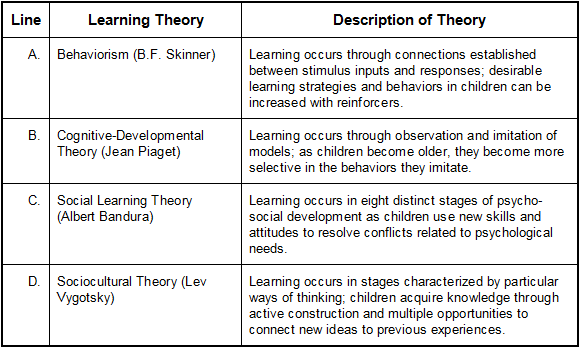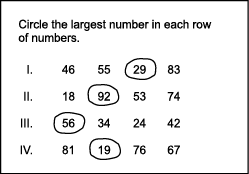Study Guide
Field 002: Early Childhood
Sample Multiple-Choice Questions
Knowledge of Child Development
Objective 0001
Understand child development from prenatal through the early elementary years.
1. Which line on the table below correctly matches a major learning theory with the view of learning associated with that theory?

| Line | A. | Behaviorism (B.F. Skinner) | Learning occurs through connections established between stimulus inputs and responses; desirable learning strategies and behaviors in children can be increased with reinforcers. |
|---|---|---|---|
| B. | Cognitive-Developmental Theory (Jean Piaget) | Learning occurs through observation and imitation of models; as children become older, they become more selective in the behaviors they imitate. | |
| C. | Social Learning Theory (Albert Bandura) | Learning occurs in eight distinct stages of psycho-social development as children use new skills and attitudes to resolve conflicts related to psychological needs. | |
| D. | Sociocultural Theory (Lev Vygotsky) | Learning occurs in stages charaterized by particular ways of thinking; children aquire knowledge through active construction and multiple opportunities to connect new ideas to previous experience. |
- Line A
- Line B
- Line C
- Line D
- Answer
- Correct Response: A.
2. Which of the following types of play behavior found among preschool children typically appears last in the sequence of development?
- playing alongside another child and imitating that child's play
- engaging in a solitary activity such as sand or water play
- agreeing on a fantasy theme and acting it out with other children
- building something with other children and then dismantling it
- Answer
- Correct Response: C.
Objective 0002
Understand child development and learning in students with disabling conditions
or exceptionalities.
3. A second grader with a mild intellectual impairment would most likely need the classroom teacher to provide:
- constant reminders to be cooperative and nonaggressive.
- constant reinforcement and guidance in how to perform routine activities such as lining up for recess.
- specific instruction in ways to recall and apply information.
- frequent reminders of the consequences for off-task or inattentive behavior.
- Answer
- Correct Response: C.
Knowledge of Children's Literature and the Writing Process
Objective 0003
Understand children's literature, including genres, literary elements, and literary
techniques.
4. Picture books are an essential part of children's literature primarily because they feature:
- repetition and other elements that foster children's appreciation of language.
- rhyming words and sentences that reduce the cognitive demands on young readers.
- images that promote young readers' understanding of complex events or relationships.
- grammatical structures that mimic conversation and strengthen children's communication skills.
- Answer
- Correct Response: C.
Objective 0004
Understand principles and concepts of writing for various purposes.
5. Children who are emergent writers would benefit most from opportunities to:
- explore and learn about a variety of writing materials.
- talk with a teacher about writing.
- copy the texts of favorite story books.
- use magnetized letters to create pictures and designs.
- Answer
- Correct Response: A.
6. Use the information below to answer the question that follows.

Main circle in center is Our Trip to the Zoo. Lines are drawn to circles scary, pretty, and funny. Lines drawn from scary to snakes and lion's roar. Lines drawn from pretty to peacocks, parrots, and butterflies. Lines drawn from funny to penguins and elephant's bath.
After taking a field trip to the zoo, a teacher leads the class in making the semantic web shown above. As a prewriting activity, creating this web would be most useful for helping students to:
- select details they want to include.
- recognize unnecessary information.
- consider the interests of their audience.
- organize their ideas for writing topics.
- Answer
- Correct Response: D.
Core Knowledge in the Content Areas
Objective 0005
Understand principles and concepts of mathematics.
7. Use the information below to answer the question that follows.

Row 1. I. 46 55 29 83; 29 is circled. Row 2. II. 18 92 53 74; 92 is circled. Row 3. III. 56 34 24 42; 56 is circled. Row 4. IV. 81 19 76 67; 19 is circled.
The circled numbers show the responses chosen by a first-grade student on an assessment. According to these assessment results, the student needs additional instruction in which of the following topics?
- absolute value
- place value
- commutative operations
- inverse operations
- Answer
- Correct Response: B.
8. Which of the following illustrates the operation 3  ÷
÷  ?
?
- A section of curved road 3
 miles long is being straightened and its length reduced by
miles long is being straightened and its length reduced by  . How long will the new road be?
. How long will the new road be? - A writer uses 3
 packages of paper preparing a manuscript. If an average chapter of the manuscript requires
packages of paper preparing a manuscript. If an average chapter of the manuscript requires  of a package, how many chapters is the manuscript?
of a package, how many chapters is the manuscript? - A car travels for 3
 miles east and then
miles east and then  of a mile north. At the end of the trip, how far is the car from its starting point?
of a mile north. At the end of the trip, how far is the car from its starting point? - A basketball team has 3
 hours of practice time per week. If the team has 3 practice sessions of equal length each week, how long is each practice session?
hours of practice time per week. If the team has 3 practice sessions of equal length each week, how long is each practice session?
- Answer
- Correct Response: B.
Objective 0006
Understand principles and concepts of history and social science.
9. Which of the following quotations best expresses the founding principle of popular sovereignty guaranteed by the U.S. Constitution?
- "Every citizen may freely speak, write and publish his sentiments on all subjects, being responsible for the abuse of that liberty."
- "All political power is inherent in the people . . . and they have at all times an undeniable and indefeasible right to alter their form of government in such manner as they may think expedient."
- "The people shall be secure in their persons, houses, papers and possessions from unreasonable searches or seizures."
- "All courts shall be open, and every person, for an injury done to him in his person, property or reputation, shall have remedy by due course of law."
- Answer
- Correct Response: B.
Objective 0007
Understand principles and concepts of science and technology/engineering.
10. A kindergarten teacher develops an activity in which students drop common objects (keys, nails, pencils, corks, marbles, pieces of soap) into a water table. Students record which of the objects float and which sink. The class then discusses what properties the objects that float have in common and what properties the objects that sink have in common. This activity would be most useful for introducing which of the following concepts to the students?
- shape
- mass
- density
- volume
- Answer
- Correct Response: C.